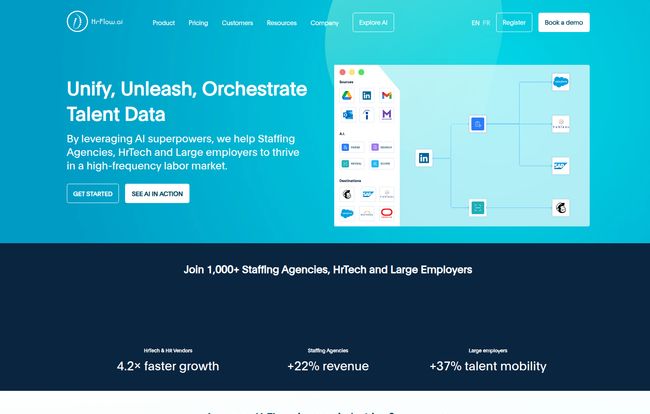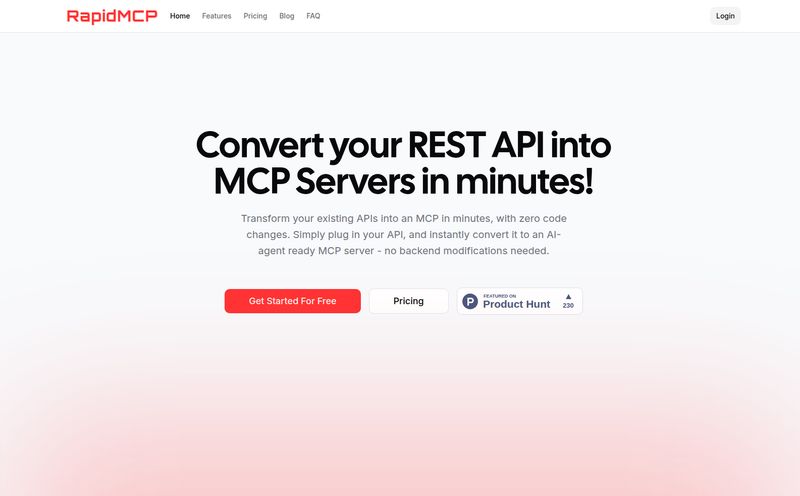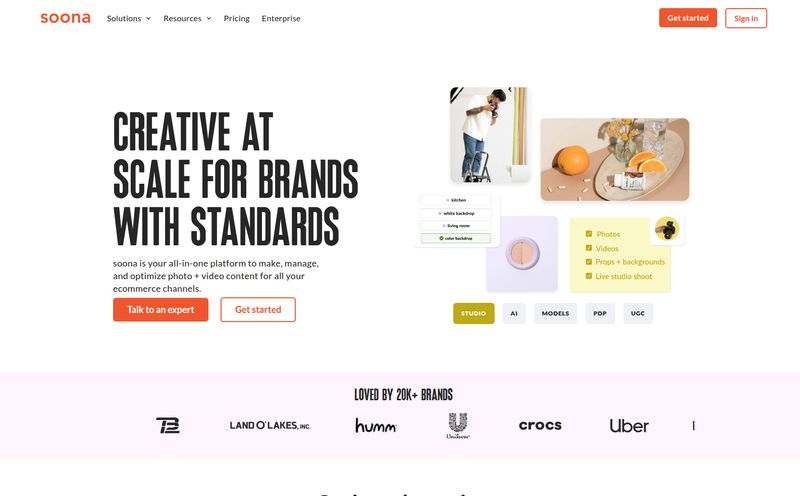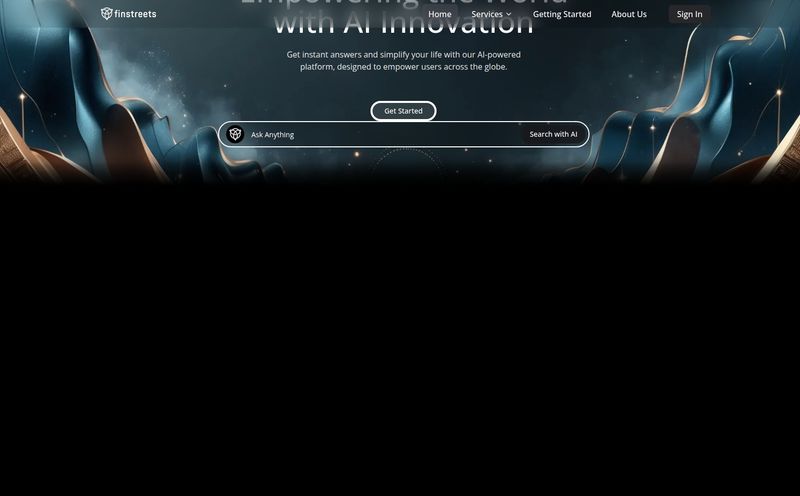If you're in HR, recruiting, or running a staffing agency, your data life is probably a mess. I'm not judging! It's just the reality of the game. You've got resumes piling up in one folder, candidate info in your Applicant Tracking System (ATS), skills data in a forgotten spreadsheet, and client needs coming in via email. It’s a bit like trying to cook a gourmet meal with ingredients scattered across three different kitchens. The result? Chaos. A digital junk drawer of human potential.
For years, we've been promised a solution. A single platform to rule them all. But most of the time, we just end up with another silo. Another tool that doesn't talk to the others. So when I came across HrFlow.ai, with its big claims of unifying and orchestrating talent data, my inner cynic sat up and took notice. Another buzzword-filled promise? Or something genuinely different?
As someone who's spent years wading through the murky waters of SEO and tech trends, I've seen countless “AI-powered” solutions. Most are just a thin veneer of AI over an old process. But HrFlow.ai felt different from the jump. Their secret sauce isn't just the AI, it's their API-first approach. And that, my friends, is where things get interesting.
What Exactly is HrFlow.ai? (Beyond the Buzzwords)
Okay, let's cut through the marketing fluff. HrFlow.ai is NOT another ATS or a Human Resources Information System (HRIS). You don't log into it to manage your company holidays. Think of it less as a new appliance in your kitchen and more as the master plumber who connects all the pipes. It’s an API-first data automation platform designed to sit in the middle of your existing tools and make them all speak the same language.
What does 'API-first' even mean? Imagine you have a bunch of awesome gadgets, but they all have different plugs. A European plug, an American one, a weird one from that one hotel you stayed at in 2008. An API (Application Programming Interface) is like a universal adapter. HrFlow.ai provides a central hub of these adapters specifically built for the chaotic world of HR data.
It's built for folks who deal with a high volume of people-data: large employers, busy staffing agencies and especially the HR tech companies that build the tools we use every day. Their whole goal is to take unstructured data—like a PDF resume or a messy job description—and turn it into clean, structured, and usable information that can be zapped anywhere it needs to go.
The Core Engine: A Look at HrFlow.ai's AI APIs
This is where the magic happens. The platform is built around a suite of powerful APIs, each designed to handle a specific part of the data journey. It’s not just one thing; it's a whole assembly line for talent information.
The Foundation: Resume & Job Parsing API
This is the front door. We've all been there, manually copying and pasting information from a resume into a database. It's soul-crushing work. HrFlow.ai’s Parsing API automates this entirely. You feed it a resume (or a job post), and it intelligently extracts, categorizes, and structures everything: contact info, work experience, skills, education, you name it. It's the first and most critical step to taming the chaos.
Adding Context: The Tagging & Embedding APIs
Once the data is extracted, what do you do with it? This is where many systems fall flat. HrFlow.ai goes a step further. Its Tagging API analyzes the text and adds smart tags. It doesn't just see the word “Python”; it identifies it as a programming language. It sees “PMP” and knows it's a certification. This contextual understanding, or 'embedding' in AI-speak, is what makes the data searchable in a truly meaningful way. It turns a dumb block of text into a rich, queryable profile.

Visit HrFlow.ai
Finding the Needle in the Haystack: Searching & Scoring
Because all your data is now structured and tagged, you can perform some seriously powerful searches. Forget simple keyword matching. You can ask complex questions like, “Show me all candidates with 5+ years of Javascript experience who have also worked in the SaaS industry and have managed a team.”
The Scoring API takes this even further by automatically comparing a candidate's profile against a specific job description and giving it a relevance score. Imagine uploading a new job and instantly getting a ranked list of the best-fit candidates already in your database. The time savings are just… immense. We’re talking a potential for +32% revenue and 4.2x faster growth according to their site. Big numbers, but I can see the path to them.
Looking to the Future: The Upskilling API
This is the feature that really got me excited. It’s proactive, not just reactive. The Upskilling API can analyze an employee's or candidate's current skill set, compare it to a target role, and identify the gaps. It can then suggest courses or pathways to bridge that gap. This is huge for internal mobility (+37% talent mobility is another one of their stats) and employee retention. Instead of losing good people, you can help them grow into their next role within your company. It’s a brilliant, forward-thinking tool.
Let's Talk Brass Tacks: HrFlow.ai Pricing and Plans
Alright, the all-important question: how much does this cost? HrFlow.ai uses a tiered model, which is pretty standard for this kind of platform. Here's a quick rundown based on their pricing page:
- Free: This is for developers and early-stage projects. You get 100 API calls per month, which is more than enough to kick the tires and see how it works. You get the basic Parsing API and some other goodies. It's a genuinely useful free tier.
- Essentials: Aimed at growing businesses, this plan bumps you up to 10,000 API calls/month and adds the crucial Tagging and Searching APIs. It's a pay-as-you-go model.
- HRtech+: This is for other software companies that want to build HrFlow.ai’s power into their own products. It adds the Scoring API and offers volume-based pricing.
- Staffing+: The top-tier plan for large-scale recruiting operations, with all the features and committed-use discounts.
Now, the elephant in the room: there's no public pricing for the HRtech+ and Staffing+ plans. I know, I know, it's a little frustrating. But it's a common practice for enterprise-level B2B tools. The pricing likely depends heavily on your specific volume, support needs, and any custom work required. My take? It signals that they're focused on building partnerships with larger clients rather than just selling a one-size-fits-all product. The good news is that the Free and Essentials tiers are transparent, so you can start small and scale up.
The Good, The Bad, and The API-Dependent
No tool is perfect. After digging in, here’s my honest take on the highs and lows.
The Good Stuff
The biggest pro is the sheer comprehensiveness of the toolset. It's a complete, end-to-end data pipeline. The API-first design is a massive plus for any organization that values flexibility and wants to create a custom, best-of-breed tech stack. You aren't locked into their ecosystem; you're empowered by it. The suite of connectors for both sourcing and sending data is also a huge time-saver.
The Potential Hiccups
Let's be clear: this is not a plug-and-play solution for a non-technical HR manager. The website says it right there: "Integrate HrFlow.ai with your favorite stack, framework or platform." You'll see logos for Python, Java, PHP. This means you need a developer or a tech-savvy team to truly harness its power. If you don't have those resources, this might be a non-starter.
Secondly, you are placing a lot of trust in the AI. While the tech has gotten incredibly good, no AI is 100% perfect. What if it mis-parses a key qualification or misunderstands a crucial skill on a resume? You need to have processes to account for that. Garbage in, garbage out still applies.
So, Who Is This Really For?
After all this, it’s pretty clear who wins with a tool like HrFlow.ai.
HR Tech Companies: This is a dream for them. They can build HrFlow.ai’s powerful parsing, searching, and scoring features directly into their own ATS or HR platform, saving them years of development time.
High-Volume Staffing Agencies: If you're processing hundreds or thousands of candidates a week, the automation here could fundamentally change your business. It turns manual data entry into a strategic advantage.
Large Corporations: For big companies focused on internal mobility and skills mapping, this is a powerful engine to understand the talent you already have before looking outside.
Who is it not for? Probably a small business that hires a few people a year. It would be like using a sledgehammer to crack a nut. The investment in technical integration just wouldn't make sense.
Frequently Asked Questions about HrFlow.ai
1. Is HrFlow.ai an Applicant Tracking System (ATS)?
Nope! It’s designed to integrate with and enhance your existing ATS. It makes the data going into your ATS cleaner and the data already in it more searchable.
2. Do I need to be a developer to use HrFlow.ai?
To get the most out of it by integrating the APIs, yes, you'll need access to development resources. While they may have some no-code integrations through their connectors, its core strength lies in its API.
3. How accurate is the AI parsing and tagging?
Leading AI models for this are highly accurate, often exceeding 95% for standard resume formats. However, accuracy can vary with unusual layouts. The best part is the free tier lets you test its performance with your own sample documents before committing.
4. What kind of tools can HrFlow.ai connect to?
Thanks to its API-first nature and its library of source and destination connectors, it can theoretically connect to any modern HR tool that has an API — think ATSs, HRISs, CRMs, and business intelligence platforms.
5. Is there a free trial?
Even better! They have a free-forever plan that gives you 100 API calls per month, which is perfect for testing and small-scale projects.
My Final Take: Is It Worth The Integration?
So, here’s my final thought. HrFlow.ai is not another simple SaaS tool. It's an infrastructure investment. It’s for organizations that have recognized that their biggest bottleneck isn't a lack of candidates, but a lack of ability to properly understand and access the candidate data they already have.
If you're drowning in a sea of resumes, struggling to connect your various HR systems, and you have the technical resources to implement an API-driven solution, then HrFlow.ai looks like a seriously powerful ally. It feels less like a product and more like a strategic partner for building a modern, efficient, and intelligent recruiting machine.
For everyone else, it’s a fascinating glimpse into the future of HR. A future where data isn't just stored, it's understood, orchestrated, and put to work.



